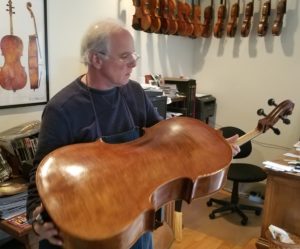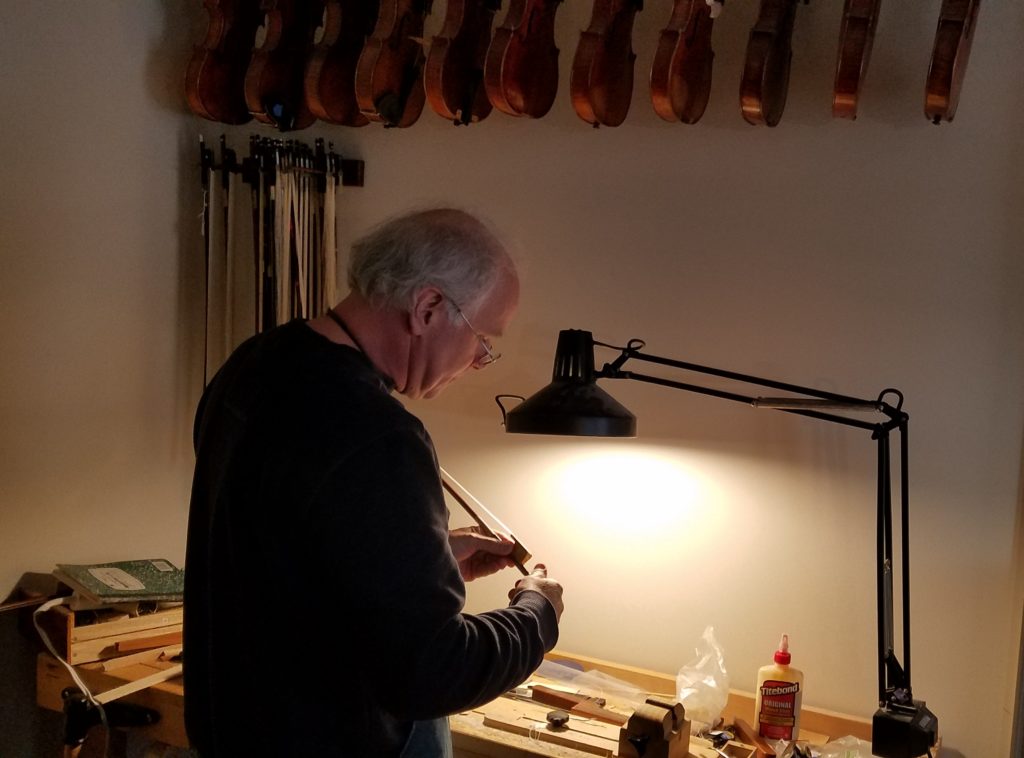
Just west of Hillsborough’s Churton Street main drag, the first block of West Tryon is like a trip back in time. That’s where you’ll find Hillsborough’s Old Town Cemetery, final resting place of some of North Carolina’s most notable long-ago politicians. It’s the home address of renowned novelist Allan Gurganus, celebrated author of “Oldest Living Confederate Widow Tells All.” And right across the street from the cemetery is Swanson Violins, a one man show that’s a true throwback.

Six days a week, you’ll find 56-year-old proprietor David Swanson toiling away in his workshop, a small house of about a thousand square feet that was previously a dentist’s office. Swanson has converted it into a space where he can make violins, violas and cellos the old way, by hand, with painstaking attention to detail. Every wooden piece is cut and carved by hand. And while some violin-crafting methods have changed over the years, the end product has changed very little for one simple reason: It’s pretty hard to improve on perfection.
“Violins have been around in their current form for about 500 years and the reason they’ve not changed much in that time is because the violin is perfection in design,” Swanson says. “Classical proportions make it the perfect amplifier of music. People try to improve that, but it’s usually more to understand why it’s perfect than to actually make it better because you can’t.”
Swanson was born in Northern Kentucky and grew up near Cincinnati in a musical family (his mother is an accomplished cellist). He started playing piano before graduating to guitar and mandolin, and he started out making the latter when he got into instrument-building.
He studied landscape architecture at the University of Georgia and worked in the field for a decade, but he was always repairing, tinkering with and building instruments on the side. Eventually he came to focus on violins, studying at the Chicago School of Violin Making after committing to full-time instrument-making.
Schooling aside, however, most of his education has come from hands-on trial and error.
“Violin-making is a total immersion thing,” he says. “You have to be around it all the time, doing it all the time in order to get good at it. It’s a lot of work for a little reward for a long, long time when you’re getting started. The only way to learn this is to do it. You can’t learn it sitting in a basement or reading the internet, you just can’t.”
Swanson also runs an instrument-rental program as a cheap way to get people into playing, and nowadays he actually spends more time repairing than building instruments. But his bread and butter is still making instruments. While violins used to account for more than three-quarters of Swanson’s business, nowadays more than half of it is cellos. Violas (which to the layman appear to be a larger, deeper-toned violin) represent a small but growing sideline.
The woodworking part of the process can take about six weeks for a violin, but at that point it’s still nowhere near finished. Although you might think there’s nothing more to the varnishing stage than slapping it on, it’s surprisingly complicated and time-consuming – and a lot of it comes down to the weather.
“There’s no substitute for setting it out in the sun,” he says. “It’s an oil resin varnish that doesn’t air-dry, the oil polymerizes and changes the chemistry to dry through ultraviolet light. And it’s always been this way. In Italy 300 years ago, the top of Stradivari’s house had an open-air area where he’d hang violins out to dry after varnishing them.”
Most of Swanson’s customers are classical players, but he has a fair amount of customers from the bluegrass and old-time world, too. And for any level of player, spending more money does not necessarily get you a better instrument.
“Whether you’re a student or a professional, the bottom line is you have to like what you get because that will encourage you to play,” he says. “[Master classical violinist] Joshua Bell could pick up whatever instrument and sound great, but he wouldn’t like a cheap factory violin because he’d be unable to do what he wants with it. We tend to put too much weight on the instrument when it’s really the player. You don’t want a violin that holds you back, but good players can make any instrument sound really, really good.”

